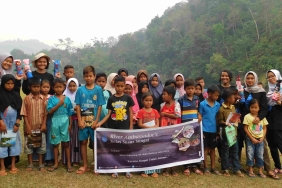ROAD INFRASTRUCTURE MUST BE ENVIRONMENTALLY FRIENDLY
By: Darmansyah Lubis
Pekan Baru - The WWF Indonesia team mentioned the need for landscape connectivity in the Riau, Jambi and West Sumatra (RIMBA) corridor area. This connectivity is expected to be supported by environmentally friendly infrastructure development efforts. This is in accordance with the mandate of Presidential Regulation No. 13 of 2012 concerning the Spatial Planning of Sumatra Island.
However, the results of a WWF Indonesia study through the InVest (Integrated Valuation for Ecosystem Services and Tradeoffs) approach stated that there were critical conditions due to highway construction that crossed protected and conservation forest areas in the RIMBA Corridor ecosystem area.
For example, the road that penetrates the conservation area in the RIMBA Corridor is in the Bukit Batabuh Protected Forest area. There is a road about 9.3 km long that cuts through the RIMBA corridor area. The road cuts the animal path from Taluk Kuantan - Kiliranjao.
The RIMBA corridor is one of the areas that still has biodiversity potential. WWF Indonesia's InVest results show that humans are the group that enters the corridor the most. (See Appendix Table)
For this reason, WWF Indonesia encourages the concept of ecoroad, an environmentally friendly highway development concept. Where, various social and ecological development interests can still be well maintained.
The concept of environmentally friendly road infrastructure development is certainly important to consider because every infrastructure development always has an impact on the sustainability of the environment, "said the Manager of the Conservation Science Unit (CSU) WWF Indonesia on the occasion of the Ecoroad Construction Workshop at the Premier Hotel, Pekan Baru, Thursday (4/5) morning.
The Directorate of Highways of the Ministry of Public Works/People's Housing (PU/PR) agreed. In the national planning, for example, national roads consist of toll and non-toll roads totaling 10 percent of the existing highways in Indonesia. Another ten percent are provincial roads. The rest are the responsibility of local governments.
Nationally, national road construction has a target until 2019 of 47,017 km and 989 km of toll roads.
Total Road Length: 504,592 km
National Non-Toll Road: 47,017 km (Authority of the Ministry of PUPR)
Toll Road: 989 km (Authority of the Ministry of PUPR)
Provincial Road: 46,863 km (Provincial Government Authority)
District/City Roads: 409,723 km (District/City Government Authority)
Data Directorate of Highways Ministry of Public Works/PR
Ir Subaiha Kipli, MT, Head of Sub-Directorate of Environment and Road Safety, Directorate of Highways, Ministry of Public Works and Housing, said that the Ministry of Public Works and Housing also has a basic regulation that lays down the requirements for environmentally friendly development. "But we can only build. The problem is that it is the local government that maintains the infrastructure that is built. Because our job is only to build," Subaiha said at the event supported by Millennium Challenge Account Indonesia (MCAI).
But often the infrastructure that is built is not guarded by the local government. A case in point is the Kelok Sembilan bridge in West Sumatra. Initially this bridge was built with environmental interests in mind. But because there was no local government attention, eventually people appeared who opened stalls of merchandise.
"That's why I hope that in the EIA document it must be emphasized that the social impact due to infrastructure development must be emphasized that the person in charge is the local government," said Subaiha.
Mitigation
Meanwhile, Ir Anshori Djamsal, MT, a lecturer from the University of Lampung, said that a lot of infrastructure built by the government has not considered the interests of a sustainable environment. Starting from the construction of toll roads, railways and other highways, it often does not consider the interests of living things at large.
Admittedly, roads are one of the most destructive infrastructures for habitat pathways. For example, the Sumatran highway will definitely affect the habitat. "Let alone elephants, even frogs are also disturbed. So the construction of highways, toll roads and railways, has disrupted the quality of habitat. Nowadays, our government cannot carelessly build roads. Because of the ecoroad concept, road construction must balance the interests of living things. Both flora and animals," said Anshori.
For this reason, mitigation is needed in building roads. Especially those that cross conservation and high-priority areas. The mitigation efforts must consider 3 aspects, among others. Among others: integrated planning of conservation, habitat conservation, and transportation. The second is mitigation to reduce the impact of roads on wildlife. Third, re-establishing habitat pathways and habitat corridors. The last is to encourage changes in the behavior and perspective of road users towards wildlife.





